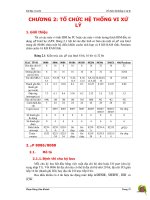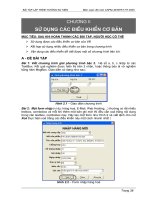Chuong 2 telnet
Bạn đang xem bản rút gọn của tài liệu. Xem và tải ngay bản đầy đủ của tài liệu tại đây (661.46 KB, 41 trang )
Chapter 18
Remote Login:
Telnet
Objectives
Upon completion you will be able to:
• Understand how TELNET works
• Understand the role of NVT in a TELNET communication
• Understand TELNET option and suboption negotiation
• Know how control characters are used
• Know the TELNET modes of operation
TCP/IP Protocol Suite
1
Note:
TELNET is a general-purpose
client-server application program.
TCP/IP Protocol Suite
2
18.1 CONCEPT
TELNET enables the establishment of a connection to a remote system
in such a way that the local terminal appears to be a terminal at the
remote system.
The topics discussed in this section include:
Time-Sharing Environment
Login
TCP/IP Protocol Suite
3
Figure 18.1
TCP/IP Protocol Suite
Local login
4
Figure 18.2
TCP/IP Protocol Suite
Remote login
5
18.2 NETWORK VIRTUAL
TERMINAL (NVT)
Via a universal interface called the Network Virtual Terminal (NVT)
character set, the TELNET client translates characters (data or
commands) that come from the local terminal into NVT form and
delivers them to the network. The TELNET server translates data and
commands from NVT form into the form acceptable by the remote
computer.
TCP/IP Protocol Suite
6
Figure 18.3
TCP/IP Protocol Suite
Concept of NVT
7
18.3 NVT CHARACTER SET
NVT uses two sets of characters, one for data and one for control. Both
are 8-bit bytes.
The topics discussed in this section include:
Data Characters
Control Characters
TCP/IP Protocol Suite
8
Figure 18.4
TCP/IP Protocol Suite
Format of data characters
9
Figure 18.5
TCP/IP Protocol Suite
Format of control characters
10
Table 18.1 Some NVT control characters
TCP/IP Protocol Suite
11
18.4 EMBEDDING
The same connection is used by TELNET for sending both data and
control characters. TELNET accomplishes this by embedding the control
characters in the data stream.
TCP/IP Protocol Suite
12
Figure 18.6
TCP/IP Protocol Suite
An example of embedding
13
18.5 OPTIONS
TELNET lets the client and server negotiate options before or during the
use of the service. Options are extra features available to a user with a
more sophisticated terminal.
TCP/IP Protocol Suite
14
Table 18.2 Options
TCP/IP Protocol Suite
15
18.6 OPTION NEGOTIATION
To use any of the options first requires option negotiation between the
client and the server. Four control characters are used for this purpose.
The topics discussed in this section include:
Enabling an Option
Disabling an Option
Symmetry
TCP/IP Protocol Suite
16
Table 18.3 NVT character set for option negotiation
TCP/IP Protocol Suite
17
Figure 18.7
TCP/IP Protocol Suite
Offer to enable an option
18
Figure 18.8
TCP/IP Protocol Suite
Request to enable an option
19
Figure 18.9
TCP/IP Protocol Suite
Offer to disable an option
20









